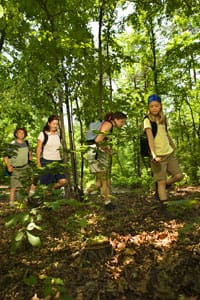Outdoor therapy, also known as wilderness or adventure therapy, is a form of psychotherapy that’s used to treat individuals who suffer from mental or emotional issues such as post-traumatic stress disorder (PTSD), depression, and drug addiction. In some cases, the term also refers to a form of physical therapy that uses the outdoors to promote healing. For troubled teens, this active form of therapy can be life changing, especially when it is included as a part of a rehabilitation program to help heal the mind and set the tone for a healthy and balanced life. Outdoor therapy is a broad term that can include activities such as high and low ropes courses, backpacking, hiking, canoeing and whitewater rafting. For at-risk-teens, this rigorous physical approach appears to be especially effective, placing them in a situation where their conquering of challenges outdoors helps provide real-life experience to draw on and even a catalyst for recovery.
History
Technically, outdoor psychotherapy has been in practice for about 40 years; however, using interaction with nature as a way to promote health and wellbeing has been recorded in ancient Egypt and other civilizations. In Japan, the act of shinrin yoku, literally “forest bathing,” is a preventive medicine practice with roots in Shinto and Buddhist practices dating back thousands of years. The first scientific documentation of using the outdoors to improve mental health was written in the early 1800s when, during mental health clinic evacuations or patient quarantine, therapists noticed that their clients were generally calmer and had increased social interactions outdoors in tents than they did behind the institution’s brick walls. The results were so dramatic, that by the 1930s the first program to utilize the outdoors as psychotherapy was launched. Since then, outdoor therapy has become widely popular, and its effects well-documented.
Benefits
Ask any outdoor enthusiast, from pro mountain bikers to weekend warriors, and they will offer a whole list of benefits that being in the outdoors gives them. Some of these, such as feelings of a deeper spiritual connection or oneness with nature, are difficult to explain and impossible to measure. Other physical benefits, however, are becoming well known and established in the medical and educational field. With today’s sedentary lifestyle, the exercise provided by wilderness therapy alone comes with a host of benefits, from weight loss and improved fitness to higher self-esteem and improved focus. For teens or young adults struggling with drug, alcohol, gaming or other addiction, the unique environment provided by wilderness therapy programs can be very effective. These programs’ high rates of success are due in part to lower stress levels, a greater sense of responsibility toward others, group cohesion, and greater self-esteem. There are numerous studies showing the health benefits of spending time in nature. One study shows that people living near parks or wilderness have longer lifespans. Other studies show that direct sun exposure from the outdoors boosts both vitamin D levels and moods. One very interesting study reports that patients exposed to the outdoors healed faster and required fewer pain medications than patients kept inside. According to another report, numerous studies have shown that contact with nature reduces blood pressure, reduces cholesterol, and dramatically reduces even acute levels of stress. Perhaps living as a part of nature and overcoming its challenges is simply therapeutic because it gets us back to humanity’s roots, where for thousands of years nature was all there was.
Outward Bound
There are dozens of intensive wilderness therapy programs available for teens struggling with issues ranging from mild social anxiety to severe chemical dependency. One of the first to launch the idea of wilderness “adventure” outdoor experience as a personal growth tool is Outward Bound. This organization catered to young adults from the very beginning. It was founded during World War II as a way to teach vital seafaring skills to young sailors. The program’s experimental learning approach that focused on building self-esteem and personal responsibility through physical challenges quickly caught on, and by the 1960s was firmly in place in the US to help develop leadership and survival skills. This basic wilderness program eventually expanded to include low-risk troubled teens and veterans. Outdoor Bound’s highly popular Intercept program for at-risk teens has become the model that inspires many wilderness therapy programs around the world. Like similar wilderness therapy programs, it puts an emphasis on teamwork, self-sufficiency, and working through difficult challenges in a completely new, and often isolated, environment. These courses can take anywhere from a couple days to nearly a month to complete. For many teens, a wilderness experience course may be just what is needed to break a vicious cycle. For others, however, a therapist-run rehabilitation program using outdoor therapy may be a better option. Keep in mind that the rigors of wilderness therapy come with risks, and may not be appropriate for every situation. Choosing the right intervention therapy and program can be a difficult process, and is best handled with the help of a licensed professional. References//natsap.org///www.outwardbound.org/#intercept-slide//www.outsideonline.com/fitness/wellness/Take-Two-Hours-of-Pine-Forest-and-Call-Me-in-the-Morning.html//www.strugglingteens.com/opinion/wildernesstherapy.html

